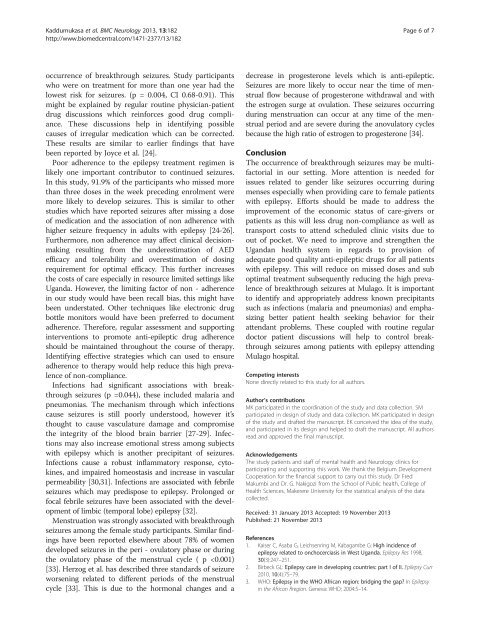The frequency and precipitating factors for breakthrough seizures ...
The frequency and precipitating factors for breakthrough seizures ...
The frequency and precipitating factors for breakthrough seizures ...
Create successful ePaper yourself
Turn your PDF publications into a flip-book with our unique Google optimized e-Paper software.
Kaddumukasa et al. BMC Neurology 2013, 13:182 Page 6 of 7<br />
http://www.biomedcentral.com/1471-2377/13/182<br />
occurrence of <strong>breakthrough</strong> <strong>seizures</strong>. Study participants<br />
who were on treatment <strong>for</strong> more than one year had the<br />
lowest risk <strong>for</strong> <strong>seizures</strong>. (p = 0.004, CI 0.68-0.91). This<br />
might be explained by regular routine physician-patient<br />
drug discussions which rein<strong>for</strong>ces good drug compliance.<br />
<strong>The</strong>se discussions help in identifying possible<br />
causes of irregular medication which can be corrected.<br />
<strong>The</strong>se results are similar to earlier findings that have<br />
been reported by Joyce et al. [24].<br />
Poor adherence to the epilepsy treatment regimen is<br />
likely one important contributor to continued <strong>seizures</strong>.<br />
In this study, 91.9% of the participants who missed more<br />
than three doses in the week preceding enrolment were<br />
more likely to develop <strong>seizures</strong>. This is similar to other<br />
studies which have reported <strong>seizures</strong> after missing a dose<br />
of medication <strong>and</strong> the association of non adherence with<br />
higher seizure <strong>frequency</strong> in adults with epilepsy [24-26].<br />
Furthermore, non adherence may affect clinical decisionmaking<br />
resulting from the underestimation of AED<br />
efficacy <strong>and</strong> tolerability <strong>and</strong> overestimation of dosing<br />
requirement <strong>for</strong> optimal efficacy. This further increases<br />
the costs of care especially in resource limited settings like<br />
Ug<strong>and</strong>a. However, the limiting factor of non - adherence<br />
in our study would have been recall bias, this might have<br />
been understated. Other techniques like electronic drug<br />
bottle monitors would have been preferred to document<br />
adherence. <strong>The</strong>re<strong>for</strong>e, regular assessment <strong>and</strong> supporting<br />
interventions to promote anti-epileptic drug adherence<br />
should be maintained throughout the course of therapy.<br />
Identifying effective strategies which can used to ensure<br />
adherence to therapy would help reduce this high prevalence<br />
of non-compliance.<br />
Infections had significant associations with <strong>breakthrough</strong><br />
<strong>seizures</strong> (p =0.044), these included malaria <strong>and</strong><br />
pneumonias. <strong>The</strong> mechanism through which infections<br />
cause <strong>seizures</strong> is still poorly understood, however it’s<br />
thought to cause vasculature damage <strong>and</strong> compromise<br />
the integrity of the blood brain barrier [27-29]. Infections<br />
may also increase emotional stress among subjects<br />
with epilepsy which is another precipitant of <strong>seizures</strong>.<br />
Infections cause a robust inflammatory response, cytokines,<br />
<strong>and</strong> impaired homeostasis <strong>and</strong> increase in vascular<br />
permeability [30,31]. Infections are associated with febrile<br />
<strong>seizures</strong> which may predispose to epilepsy. Prolonged or<br />
focal febrile <strong>seizures</strong> have been associated with the development<br />
of limbic (temporal lobe) epilepsy [32].<br />
Menstruation was strongly associated with <strong>breakthrough</strong><br />
<strong>seizures</strong> among the female study participants. Similar findings<br />
have been reported elsewhere about 78% of women<br />
developed <strong>seizures</strong> in the peri - ovulatory phase or during<br />
the ovulatory phase of the menstrual cycle ( p
















